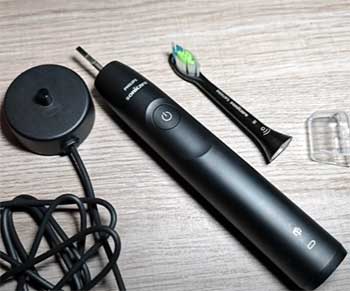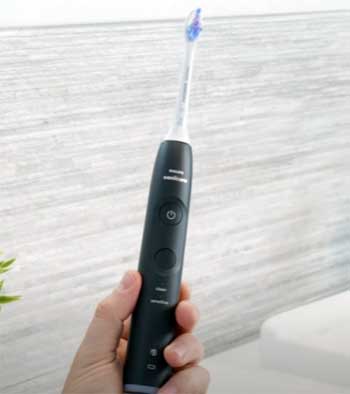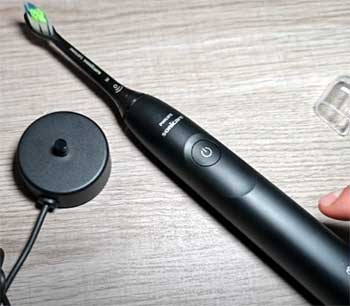I’ve been brushing my teeth twice a day for decades, but it wasn’t until I switched to an electric toothbrush that I realized how much better my oral hygiene could be. Choosing the right one, though, can feel like picking a new phone—overwhelming and full of jargon.
That’s why I’m breaking down the Philips Sonicare 5300 and 6100, two mid-range models that promise cleaner teeth and healthier gums.
My goal is to help you decide which toothbrush fits your needs, budget, and brushing style by comparing their features, pros, and cons in a real-world way.
A Brief Comparison Table
| Feature | Sonicare 5300 | Sonicare 6100 |
| Cleaning Modes | 3 (Clean, White, Gum Care) | 3 (Clean, White, Gum Care) |
| Intensity Settings | 2 (High, Low) | 3 (High, Medium, Low) |
| Brush Heads Included | 3 (1 G2 Gum Care, 2 W2 White) | 1 (W DiamondClean) |
| Pressure Sensor | Vibration alert | Vibration + visual light ring |
| Battery Life | Up to 14 days | Up to 14 days |
| Travel Case | Basic case (some variants) | Basic case (some variants) |
| BrushSync Technology | Replacement reminder | Replacement reminder + mode pairing |
| Color Options | Black gray | Multiple (e.g., white, blue, black) |
| Price (Approx.) | $80–$100 | $120–$155 |
Why I’m Comparing These Two Models?
As someone who’s tested both the Sonicare 5300 and 6100, I know firsthand how their features translate to daily use. Both are part of Philips’ ProtectiveClean series, designed to deliver powerful sonic cleaning—up to 62,000 brush movements per minute—while being gentle on gums.
They share core tech, like pressure sensors and BrushSync, but differ in ways that might sway your decision. I’ll walk you through my experience, highlighting what worked, what didn’t, and what’s worth the extra cash.
Unboxing And First Impressions
- Sonicare 5300: A Value-Packed Surprise

When I unboxed the Sonicare 5300, I was impressed by how much Philips packed into this budget-friendly model.
The sleek, lightweight handle felt good in my hand, though the lack of a textured grip made it a tad slippery when wet.
The box included three brush heads—two W2 Optimal White for whitening and one G2 Optimal Gum Care for sensitive gums—making it feel like a steal.
The matte-finished charging stand looked modern, and the basic travel case (included in some variants) was a nice touch for weekend trips.
- Sonicare 6100: A Premium Feel
The Sonicare 6100, on the other hand, screamed “upgrade” from the moment I opened the box. The handle was equally slim but came in multiple color options, letting me pick a white one that matched my bathroom vibe.
It only included one W DiamondClean brush head, which was a bit disappointing for the price. However, the dedicated cleaning mode button and LED indicators gave it a more sophisticated look. The travel case, when included, was identical to the 5300’s—functional but not fancy.
Key Features of Sonicare 5300 And 6100 Toothbrushes Breakdown
Let’s talk about what these toothbrushes actually do. Both models use Philips’ sonic technology, which creates a dynamic cleaning action by pushing toothpaste and saliva between teeth and along the gumline.
Here’s how their features stack up.
- Cleaning Modes

Both the 5300 and 6100 offer three cleaning modes: Clean (standard daily brushing), White (for stain removal), and Gum Care (gentle for gums).
I found Clean mode sufficient for most days, delivering a thorough scrub in two minutes.
White mode felt slightly more intense, which I used once a week to tackle coffee stains.
Gum Care was a lifesaver during a bout of gingivitis, as its final 30 seconds reduced intensity for a soothing finish.
The difference?
The 6100 has a dedicated button to switch modes, with LEDs showing your selection. On the 5300, you cycle through modes using the power button, which I found clunky, especially with wet hands. If you’re someone who switches modes often, the 6100’s design is a clear win.
- Intensity Settings
This is where the 6100 pulls ahead. It offers three intensity levels—Low, Medium, and High—for each cleaning mode, giving you nine possible combinations. I loved this flexibility, especially on days when my gums felt sensitive, and I could dial down to Low without sacrificing cleaning power.
The 5300, by contrast, has only two intensities: High and Low. It’s simpler, which some might prefer, but I missed the middle ground. For example, Medium on the 6100 was my sweet spot for daily brushing—powerful yet comfortable.
If you have sensitive teeth or gums, the 6100’s extra control is worth considering.
- Brush Heads and BrushSync
The 5300’s three included brush heads were a major selling point. The W2 Optimal White heads worked wonders on surface stains, while the G2 Gum Care head was gentle yet effective.
The 6100’s single W DiamondClean head was excellent for whitening but left me wanting more variety out of the box. Since replacement heads cost $10–$15 each, the 5300’s bundle saves you money upfront.
Both models feature BrushSync, which tracks brush head usage and reminds you to replace it every three months. The 6100 goes further with mode pairing: when you snap on a specific head (like W DiamondClean), it automatically selects the corresponding mode (White).
I found this handy but not essential, as I could manually select modes on the 5300 without issue.
- Pressure Sensor
Both toothbrushes have a pressure sensor to prevent over-brushing, which can damage gums and enamel. The 5300 alerts you with a vibration through the handle, which I noticed but sometimes ignored in the moment.
The 6100 adds a visual light ring at the handle’s base that glows purple when you press too hard. This dual feedback was more effective, especially during my early days of adjusting to electric brushing.
- Battery Life and Charging
Philips claims both models last up to 14 days on a single charge. In my testing, I got about 12–13 days with twice-daily brushing on Clean mode at High intensity. The 5300’s three-LED battery indicator was clear, while the 6100’s single LED was less precise but still functional.
Both use a USB-connected charging stand, which took 24 hours to fully charge—a bit slow but not a dealbreaker.
- Design and Ergonomics
The 5300’s single color option (black gray) felt a bit bland, but its lightweight handle was easy to maneuver. The 6100’s multiple colors added personality, and its dedicated mode button made operation smoother.
Both lacked a grippy texture, which was a minor annoyance when toothpaste got involved. The 5300’s physical power button was softer to press, which I appreciated during early morning grogginess.
Pros And Cons: My Real-World Experience
Sonicare 5300 Pros

- Great Value: The inclusion of three brush heads—two W2 Optimal White and one G2 Optimal Gum Care—along with a travel case (in some variants) makes the 5300 a budget-friendly powerhouse. At $80–$100, it’s a steal for the features you get.
- Versatile Brush Heads: The mix of whitening and gum care heads caters to both stain removal and sensitive gums, offering immediate flexibility without extra purchases. I found the variety perfect for switching between aggressive cleaning and gentle care.
- Solid Performance: With 62,000 brush movements per minute, three cleaning modes, and a QuadPacer timer, it delivers a dentist-level clean every time. My teeth felt noticeably smoother after just a week.
- Long Battery Life: I got nearly two weeks of twice-daily brushing on a single charge, making it ideal for travel or forgetting to charge regularly.
- BrushSync Reminder: The replacement reminder ensures you never overuse a worn-out brush head, maintaining peak performance and hygiene.
- Reliable Simplicity: The straightforward design is perfect for those who want effective cleaning without complex features, ideal for beginners or minimalists.
Sonicare 5300 Cons
- Limited Intensity Options: Only two settings (High and Low) can feel limiting, especially for sensitive gums. I often wished for a middle intensity for daily use.
- Basic Pressure Sensor: The vibration-only alert is subtle and easy to miss, especially if you’re distracted. I caught myself pressing too hard a few times.
- Single Color: The black gray finish looks sleek but lacks personality. I wished for more vibrant options to match my style.
- Clunky Mode Switching: Cycling through modes with the power button is awkward, especially with wet or soapy hands, leading to occasional misclicks.
- Slippery Handle: The smooth handle can slip during brushing, particularly with toothpaste residue, which was frustrating in a rush.
- No Visual Feedback: Without a light-based pressure sensor, it’s harder to notice over-brushing, which could be an issue for aggressive brushers.
Sonicare 6100 Pros
- Customizable Brushing: Three intensity settings (Low, Medium, High) across three modes offer nine combinations, letting you fine-tune for comfort. I loved the Medium setting for daily use.
- Visual Pressure Sensor: The purple light ring plus vibration is a clear, effective warning against over-brushing, protecting my gums during intense sessions.
- Multiple Colors: Options like white, blue, and black add a personal touch. My white 6100 looked sharp on my bathroom counter.
- BrushSync Mode Pairing: Automatically matching the brush head to the cleaning mode (e.g., W DiamondClean to White mode) simplifies use, saving time and effort.
- Premium Feel: The dedicated mode button and LED indicators give it a polished, high-end vibe that feels worth the price.
- Enhanced Control: The extra intensity level and smoother controls make it feel more tailored, especially for those with varying dental needs.
Sonicare 6100 Cons
- Higher Price: At $120–$155, it’s $40–$50 more than the 5300, which might not feel justified for the added features, especially for casual users.
- Single Brush Head: Only one W DiamondClean head is included, which feels skimpy for the cost. Extra heads cost $10–$15, adding to long-term expenses.
- Similar Battery Life: Despite the higher price, it offers the same 12–13 days as the 5300, which felt like a missed opportunity for improvement.
- No Grip Texture: Like the 5300, the smooth handle slips with wet hands, which was annoying during messy brushing sessions.
- Overkill for Some: The extra intensity and mode pairing might be unnecessary if you stick to one mode, making the 5300 a better value for basic needs.
- Less Value Upfront: With fewer included brush heads, you’re spending more initially and replacing heads sooner, which adds up over time.
My Daily Brushing Routine With Each Model
To give you a sense of how these toothbrushes fit into real life, here’s how I used them over two weeks each.
- Sonicare 5300: The Reliable Workhorse
Mornings started with Clean mode on High intensity for a quick, thorough scrub. The QuadPacer (30-second pulses) kept me on track, ensuring I brushed all quadrants evenly. Evenings were for Gum Care mode on Low, especially when my gums felt tender.
The W2 White head tackled coffee stains, and I swapped to the G2 Gum Care head for gentler brushing. The vibration-only pressure sensor was subtle, and I occasionally brushed too hard without realizing it. The travel case was handy for a weekend getaway, though I wished the handle had a better grip.
- Sonicare 6100: The Customizable Companion
The 6100 felt like a step up. I used Clean mode on Medium intensity for daily brushing, finding it the perfect balance of power and comfort. White mode on High was my go-to for stain removal, while Gum Care on Low soothed my gums.
The light ring pressure sensor was a game-changer, catching me every time I got too aggressive. Mode pairing was neat but not life-changing, as I often picked modes manually. The single brush head was a letdown, but the W DiamondClean performed well. I loved the white handle’s look, but the slippery grip was still an issue.
Which One Should You Choose?

Your choice depends on your priorities. If you’re budget-conscious and want a solid toothbrush with extra brush heads, the 5300 is a no-brainer. Its three modes and two intensities cover the essentials, and the included heads save you money long-term.
It’s perfect for first-time electric toothbrush users or those who don’t need extra bells and whistles.
If you value customization and a premium feel, the 6100 is worth the splurge. The three intensity settings and visual pressure sensor make it ideal for sensitive teeth or gums, and the dedicated mode button simplifies operation. However, the single brush head and higher price might not justify the upgrade for everyone.
I leaned toward the 6100 for its flexibility, especially since my gums vary in sensitivity. But if I were buying for someone else, like my partner who just wants a clean mouth without fuss, I’d recommend the 5300 for its value.
- Comparing To Other Sonicare Models
To put these in context, I also considered the Sonicare 4100 (more basic, no extra modes) and 6500 (pricier with Bluetooth). The 4100 is cheaper but lacks the 5300’s versatility.
The 6500 adds smart features, but I didn’t find them worth the extra $50–$70, as the core cleaning performance is similar. The 5300 and 6100 hit a sweet spot for features and price, making them standouts in the Sonicare lineup.
- Long-Term Value and Maintenance
Both models use replaceable brush heads, which cost $10–$15 each and need changing every three months. The 5300’s three heads give you a nine-month supply, while the 6100’s one lasts three months. Over a year, the 5300 saves you about $20–$30 on replacements.
Both have rechargeable batteries that should last 3–5 years, and Philips offers a two-year warranty. I found the 5300’s value stronger due to its lower upfront cost and extra heads, but the 6100’s customization might appeal if you plan to use it for years.
- What Dentists Say
I spoke with my dentist about these models, and she emphasized the importance of pressure sensors and proper brushing technique. She noted that the 6100’s visual sensor is better for patients who struggle with over-brushing, while the 5300’s simpler design suits those who follow instructions well.
Both remove up to seven times more plaque than manual brushing, per clinical studies, so you’re getting a solid clean either way.
Frequently Asked Questions (FAQ)
The 6100 has three intensity settings, a visual pressure sensor, and BrushSync mode pairing, while the 5300 has two intensities, a vibration-only sensor, and three brush heads included.
No, the Sonicare 5300 is still available as of July 2025, though availability may vary by retailer.
The 6500 adds Bluetooth and more brush heads, but the core cleaning is similar. It’s only better if you want smart features.
Yes, it’s a reliable, value-packed toothbrush with three modes, two intensities, and excellent plaque removal.
Conclusion: Your Smile, Your Choice
You’re standing at a crossroads, toothbrush in hand, wondering which Sonicare will give you that dentist-clean feeling. I’ve been there, and after testing the 5300 and 6100, I can tell you both deliver sparkling results.
The 5300 is your wallet’s friend, packed with value and versatility. The 6100 is your gums’ ally, offering control and a touch of luxury. Think about your needs—budget or customization—and pick the one that feels right.
Your smile deserves it, and you can’t go wrong with either.
